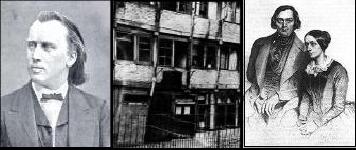

While Brahms presented the serious music of Bach and Beethoven, he wrote original compositions which he would blend into his programs, and these pieces were often variations on old German folk songs which made him popular with German audiences. His fame spread. Brahms was somewhat old fashioned and felt no kinship to the “music of the future” as did a Wagner or a Liszt, but he was studious, prodigious and had a deep reverence for music. He was so meticulous that he worked on one piece for eleven years before making it public, and he only wrote four symphonies that are known of. Extremely self-critical, Brahms strove for technical perfection, and this gave him a reputation as irritable. Above: Brahms and his birthhouse after the bombing; The Schumanns
It is estimated the chamber music we have is only one quarter of what he actually wrote, as he destroyed anything that he considered unworthy. He certainly had a soft side and displayed it to Clara Schumann to whom Brahms often first sent his works. Brahms and the Schumanns were close friends, and three years after they met, Robert Schumann fell ill and died. Brahms had consoled Clara, fourteen years his senior, during the anguish of Robert’s disease.
It is as impossible to sever Brahms from Robert and Clara Schumann, or they from each other. Robert Schumann was born in Zwickau on June 8, 1810 and showed no major interest in music until he was a young adult when Friedrich Wieck became his teacher. Wieck was quite famous and his musically gifted daughter Clara met Schumann and they fell in love. Despite her father’s grave objections, they married a day before her 21st birthday in 1840, had a big family and remained deeply in love throughout their marriage.
On the day after their wedding, Robert gave a diary to Clara, suggesting that they each write in it and exchange it weekly, which they did for several years. Today, it gives us a glimpse into their lives. Schumann had damage to his fingers, so he put his attention to composing. He became a writer and editor for a music journal launched in 1834. Throughout his life, Schumann suffered depression.
When Clara was 35, Robert Schumann’s bouts with depression continued, leading him to commit himself to an asylum after 14 years of marriage and eight children. He died there two years later on July 29, 1856. Clara was left to support her family by giving concerts and teaching. She was one of the most famous pianists of her time with a musical output of 66 pieces. She died in 1896. The Schumanns travelled throughout the heart of Germany, and it is said that Robert Schumann was so inspired by the Cologne Cathedral that he went home and composed his Rhenish Symphonies.
A lasting love for Clara ultimately developed for Brahms, although their relationship was complex and not without difficulties. Friends expected Brahms and Clara Schumann to marry. Why they did not is one of history’s secrets. Brahms dedicated many of his works to Clara, and they remained lifelong friends. Brahms was 64 years of age when Clara died in 1896. A grieving Brahms attended her graveside funeral in cold, wet weather and became ill, dying on April 3, 1897 in Vienna.
The offer was accepted, and on his way to the Danish capital in 1754 he met his future wife, Meta Möller, the “Cidli” of his odes and an enthusiastic fan. Sadly, she died in 1758, breaking his heart. He subsequently published his late wife’s writings, then turned his attention to northern mythology, which he conceived should replace classical subjects in a new school of German poetry. In 1770, he retired to Hamburg, but retained his pension together with the rank of councillor of legation.
He issued the last five cantos of the Messiah there in 1773, and he travelled south in 1775, making the acquaintance of Goethe on the way. He spent a year at the court of the Margrave of Baden at Karlsruhe and in 1776 returned to Hamburg where he spent the remainder of his life. In his older age, he was fascinated by the American War of Independence and the Revolution in France. The French Republic sent him a diploma of honorary citizenship, but, disgusted by the violence of the Revolution, he returned it. At age 67 he remarried. He died in Hamburg on March 14, 1803 and was mourned by all Germany and buried with great ceremony by the side of his wife Meta in the church graveyard of the village of Ottensen. His work has been translated into seventeen languages. Much of Klopstock’s poetry was set to music by Schubert and others.